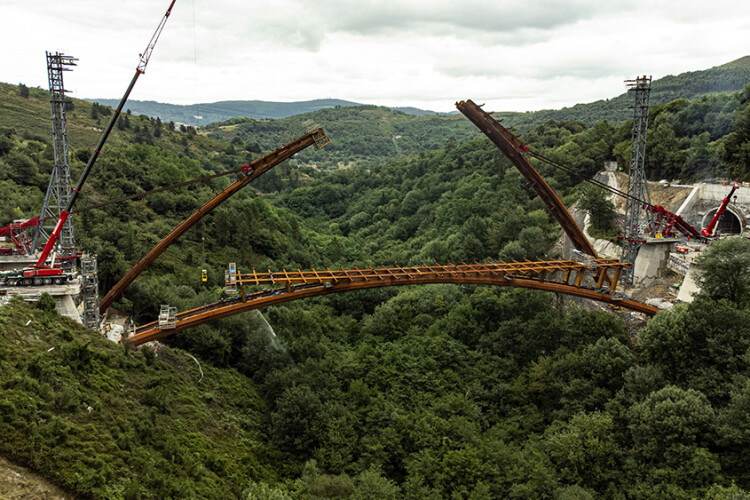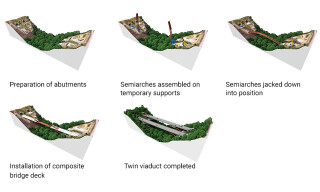Bilbao, the largest city in the Basque Country of north-western Spain, is home to one of country’s busiest ports.
Over the past two decades the Port of Bilbao has expanded considerably and continues to grow, with shipping traffic heading all over Europe and further afield. But this growth, along with the resulting urban sprawl and increased vehicle traffic across the city, has meant that the existing road network is struggling to cope.
With high levels of congestion blighting the city, the regional government commissioned construction of the new AP-8 relief road – known as the Supersur – to carry traffic bound for the port and the scenic coastline around the city instead of through it.
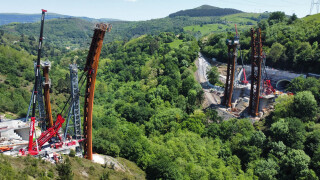
Much of the Supersur is now complete, providing a seamless route around the outskirts of Bilbao. But the final section – the construction of twin viaducts linking road tunnels on either side of the Bolintxu valley – required an impressive feat of engineering.
The 162m-long viaducts connect the 2km-long Arnotegi tunnels emerging on one side of the valley with the 620m-long Seberetxe tunnels on the other side. But the length of these bridges was only the start of the challenge for project’s client, local transport agency Interbiak, and structural engineering consultant Arenas & Asociados.
The Bolintxu valley is a protected area of natural beauty and ecological importance, and so the project needed to ensure that any structure crossing it not only had a minimal footprint but also avoided disrupting the area during construction.
Instead of working off the valley floor – a method that would have entailed widespread disturbance to the flora and fauna of the protected habitat – Arenas & Asociados decided to assemble the viaduct components off-site, transport them to the valley through the tunnels and lower them into position like the leaves of a lift-bridge.
Similar operations had already been successfully undertaken by Dutch heavy-lift and transport specialist Mammoet – most notably, in 2006, over the Tajo River in the western-central Extremadura region of Spain.
Alejandro Godoy, project manager at Arenas & Asociados explains:
“Interbiak stipulated, quite rightly, that the method of construction for the new bridges needed to take into account the potential impact on the natural environment as a primary concern. This meant that we had to explore alternative ways to solve this challenge, as a conventional approach would have been to use temporary scaffolding or support towers down in the valley”.
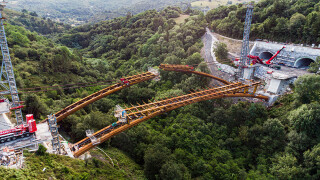
“From the beginning we thought the lowering method could be an effective alternative. Being aware that Mammoet was able to deliver such operations having seen their work at the Alconetar Arches viaduct over the Tajo River and the Bolueta Arches over the Nervion River, for the City Metro of Bilbao, they were our first call to establish the best common approach.”
Development of the engineering solution began several years before the project was due to start with technical analysis and studies carried out to understand precisely what was possible within the geography of the area.
Early on in the process it was decided that the bridges would each consist of an arch spanning the valley, supported only at the abutments on either side. It was then up to Mammoet to propose the best solution to install them.
Mammoet project manager Veronica Arrayago explains: “Avoiding disruption to the river and the valley floor meant that we looked at how a swivel arch methodology could be used, which would allow construction of the bridges by lowering an arch segment from each side of the valley.
“Although this technique has been used a handful of times in recent decades, it is not common. Further, whilst similar bridge spans have been installed this way before, the weight of each arch section – up to 1,150 tonnes – had not. So we were facing a landmark operation in every sense of the word to ensure the bridges were put into place safely and efficiently.”
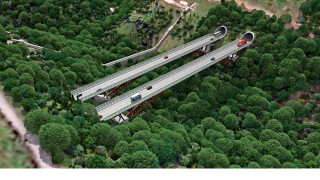
Each arch was erected in two halves – one on either side of the ravine – before lowering and tilting them slowly to meet in the centre. Each semiarch was built upright, supported by a temporary scaffolding tower and secured on top of a large fulcrum. Once both semiarches were completed, they were simultaneously tilted down and lowered, rotating on their swivels and supported by Mammoet’s hydraulic strand jack system.
Arrayago continues: “We recognised that moving such large components would present a challenge and demand some of Mammoet’s highest capacity strand jack equipment, especially as the final position of the bridges meant they would face very high tension loads.

“However, we needed to be creative in the design of the equipment and where it was installed because the space between the tunnel openings and bridge abutments was extremely limited; the tunnels had to be used for tasks such as laying out strands as they were threaded into the jacking equipment.
“Furthermore, the tunnels were the only access route in and out of the site and would also be in use for other project workflows at the same time,” says Arrayago. “So an extremely thorough plan across all phases was required in order for us to execute successfully.”
The result was a methodology that allowed each semiarch to be moved directly from where it had been constructed onto the site. Two bundles of steel ropes were connected to an elevated section of each semiarch and fed through the hydraulic strand jacks to lower the section.
The strand jacks were mounted on special steel frames that had been engineered, designed and manufactured by Mammoet specifically for the project. These steel frames were secured to temporary foundations constructed behind the abutments.
The massive forces exerted during the operation meant that multiple strand jacks would normally have been needed for each cable bundle, meaning additional steelwork, more groundwork and therefore more time and expense. Mammoet was able to avoid this thanks to the convenient fact that is possesses bigger, more powerful jacks than anybody else, says Arrayago.
“Mammoet owns a number of 1,250-tonne strand jacks, which are the largest in the world and unique to us having been custom designed to our specifications. They proved invaluable for the Bolintxu project as it allowed us to use fewer strand jacks for each arch, reducing time and cost for the client and making best use of the highly limited space on site,” she says.
The process of lowering the semiarches into their final position began by breaking the static balanced position of the semiarches while they were still connected to the temporary scaffolding towers used for their construction. For this, Mammoet mounted six 64-tonne capacity push-pull hydraulic cylinders behind each arch to generate the force required to tip the semiarch on its way down into the valley.
Each bridge section took between two and three days to install. The first day was spent completing the slow and careful equilibrium-breaking process, while the remaining time was used to lower the semiarch smoothly until it was in place ready to connect to the opposite side.
Installation of the Bolintxu Viaduct in May 2022 completed the final link in the Supersur relief road, diverting traffic from central Bilbao. Critically, this has been done with minimal impact on the natural environment and no disruption to the delicate ecology in the Bolintxu valley.
Godoy concludes: “We are delighted to have helped complete this landmark project and importantly, with the help of Mammoet, we were able to do so in a way that was compatible with the natural environment.
“Mammoet’s expertise in planning and executing the lowering operations, and their efficient access to the right specialist equipment, was crucial in making sure the work was completed safely, accurately and on time”.
Engineering the structure
The viaduct’s steel/concrete composite section arches vary in depth between 2.2m and 1.5m.
The transverse bracing between each pair of arches, spaced 5.4m apart, is carried out by means of diagonals 300mm wide and 15mm thick.
The composite deck is made up of a pair of metal box girders 1.2m wide and 850mm deep, located at 5.4m centres with transverse ribs placed every 3.33m.
The deck is 14m wide and carries two 3.5m-wide lanes, two hard shoulders of 1m and 2.5m and two pedestrian walkways of 1m and 2.5m width.
Noise protection barriers and a detailed landscape restoration plan to integrate the abutments help to protect the natural environment in the valley.
Got a story? Email news@theconstructionindex.co.uk

